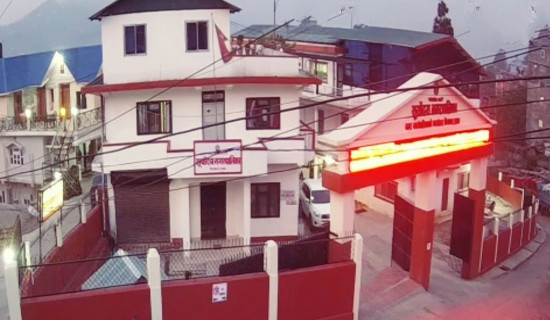- Tuesday, 26 August 2025
Nepal emerging as more peaceful nation
BY SUSHMA MAHARJAN,Kathmandu, Aug. 26: Nepal often draws criticism for not concluding the peace process as envisaged by the Comprehensive Peace Accord (CPA) inked in 2006. However, the recent reports show that Nepal is emerging as a more peaceful country. The Global Peace Index 2025 is a testomony to this.
Nepal has climbed to 76th position out of 163 countries in the Global Peace Index (GPI) 2025, published two months ago by the Australia-based NGO Institute for Economics and Peace (IEP). The GPI measures the relative peacefulness of nations and regions using 23 indicators across three domains: Societal Safety and Security, Ongoing Conflict, and Militarisation.
With an overall score of 1.987, Nepal has strengthened its position as one of South Asia’s more peaceful nations, ranking second in the region after Bhutan.
This year’s ranking reflects both progress and persistence: progress in terms of reducing conflict-related risks, and persistence in maintaining peace despite enduring socio-economic and political challenges.
The latest GPI figures show a steady upward trend for Nepal. In 2021, Nepal was ranked 85th, improved to 73rd in 2022, and now stands at 76th in 2025. While the three-place drop since 2022 may seem like a minor setback, analysts argue that Nepal’s overall trajectory demonstrates consistent stability compared to many regional peers whose scores have declined.
The report attributes Nepal’s sustained performance to a decline in violent demonstrations, relatively low homicide rates, and reliance on dialogue over armed confrontation in political disputes.
The country’s peacekeeping contributions also bolster its international reputation. Since 1958, Nepal has sent more than 119,000 personnel to United Nations peacekeeping missions, making it one of the top contributors globally.
Globally, Iceland remains the most peaceful country, followed by Ireland, New Zealand, Austria, and Switzerland.
At the other end of the spectrum, Russia makes up the least peaceful countries followed by Ukraine, Sudan, Democratic Republic of the Congo and Yemen.
Among the Gulf Corporation Council (GCC) countries, as per the report, Qatar again has been ranked the most peaceful country in the Middle East and North Africa (MENA) for the seventh time in the 2025 Global Peace Index (GPI) assessed as the country of low crime rates, strong governance, and minimal military spending. Additionally, Qatar National Vision 2030 has also contributed to the GPI as the country has been marching ahead with a clear vision of sustainable development and societal well-being.
Despite conflict in Yemen, Syria, Israel and Sudan, Qatar is
the only MENA country that stands at 27th out of 163 countries assessed by the IEP.
In South Asia, Bhutan continues to be the most peaceful at 21st globally, while Nepal holds the second-best position. Other countries in the region rank considerably lower: Sri Lanka (97th), India (115th), Bangladesh (123rd), Pakistan (144th), and Afghanistan (158th). This comparison underscores Nepal’s relative advantage in a neighborhood plagued by political turbulence, border disputes, and insurgencies.
The GPI report emphasises several areas where Nepal excels, including low militarisation, internal stability, and community resilience. These strengths have helped Nepal maintain a position in the top half of global rankings, reflecting its capacity to remain resilient despite fragile governance and economic limitations.
At the same time, the report identifies persistent challenges. Nepal’s governance remains vulnerable to inefficiencies and political deadlock. Weak institutions and limited economic opportunities pose risks for sustainable peace. Moreover, frequent natural disasters, such as earthquakes and floods, continue to add to the country’s fragility.














